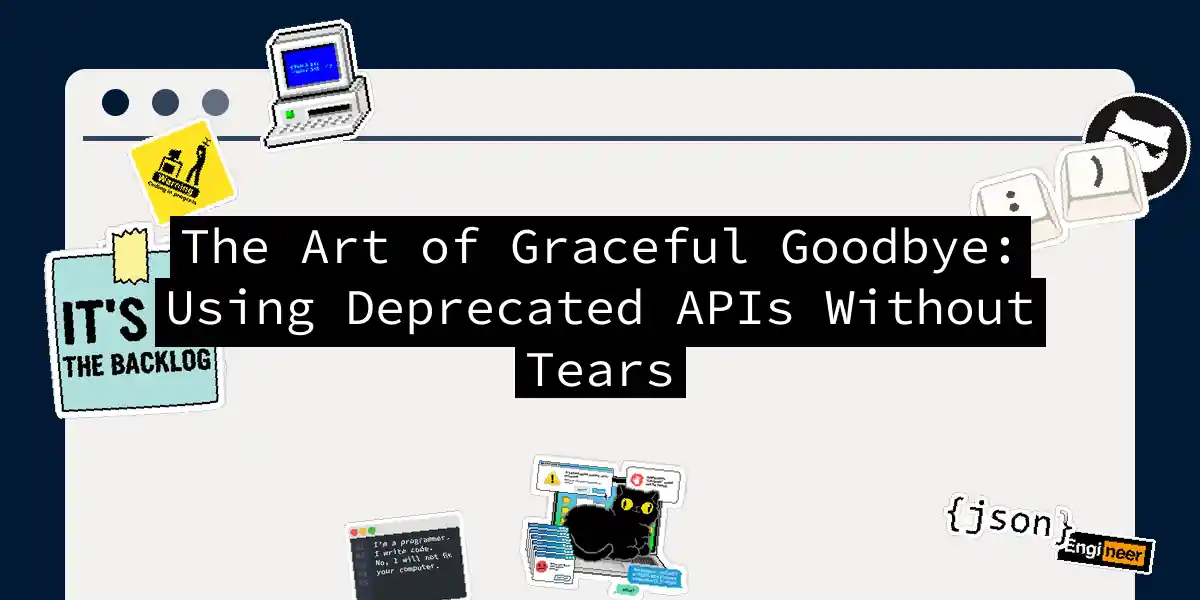Let’s face it - deprecated APIs are the leftovers of our digital kitchen. They’re still edible, but everyone side-eyes them while reaching for fresh ingredients. Yet like last night’s pizza crusts, they can still serve a purpose if handled properly. Here’s how to keep your codebase from turning into a dependency dumpster fire.
Why APIs Retire (And Why You Should Care)
APIs age like milk, not wine. They get replaced because:
- Security patches (the digital equivalent of fixing leaky pipes)
- Performance upgrades (turning a bicycle into a rocketship)
- Architectural shifts (when microservices have an identity crisis)
My first encounter with API mortality looked like this:
# OpenAPI 3.0 snippet showing version sunset
x-deprecated: true
x-sunset-date: 2026-01-01
x-replacement: /v2/payment-processor
This versioning approach saved our team from 37 angry Slack messages when we deprecated our payment gateway.
The Deprecation Survival Kit
1. Monitoring: The API Life Alert® System
Before pulling any plugs, check who’s actually using that crusty old endpoint:
curl -X GET "https://api.yourservice.com/metrics/endpoint-usage" \
-H "Authorization: Bearer $TOKEN" | jq '.legacy_v1_endpoints'
I once found our “deprecated” user-auth API was still handling 42% of traffic through an undocumented IoT device. Pro tip: always assume someone’s using your API in ways that would make you cry.
2. Communication: Don’t Ghost Your Users
Your deprecation notice should be clearer than a breakup text:
@app.route("/legacy-endpoint")
def deprecated_endpoint():
response = jsonify({"error": "Endpoint retired - see /v2/endpoint"})
response.headers["Deprecation"] = "true"
response.headers["Sunset"] = "Tue, 01 Jan 2026 00:00:00 GMT"
return response, 410 # Gone, not forgotten
Include these elements in every response:
- Version sunset date (in multiple timezones)
- Migration documentation link (that actually works)
- Support contact (preferably not a
/dev/nullemail)
The Safe Adoption Playbook
Step 1: Dependency Autopsies
When encountering deprecated code:
import warnings
def old_payment_processor():
warnings.warn(
"This method will explode on 2026-01-01. Use quantum_payment_processor()",
DeprecationWarning,
stacklevel=2
)
# Old implementation
Pro move: Create automated migration tests:
# test_deprecations.py
def test_old_endpoints_return_410():
response = client.get("/v1/old-endpoint")
assert response.status_code == 410
assert "Deprecation" in response.headers
Step 2: Version Negotiation 101
Let clients specify their comfort level:
curl -H "Accept: application/vnd.yourapi.v2+json" \
https://api.yourservice.com/resource
Golden rule: Maintain at least two parallel versions during transition periods. It’s like keeping training wheels on while learning to ride a motorcycle.
The Transition Tightrope
Real-world example: When we deprecated our SMS service:
#!/bin/bash
# Automated migration script for SMS API v1 → v3
legacy_users=$(curl -sS https://api/v1/sms-users | jq -r '.[].id')
for user in $legacy_users; do
curl -X POST https://api/v3/sms-migration/$user \
-H "Content-Type: application/json" \
-d '{"migration_strategy": "preserve-history"}'
done
When to Break Up With Legacy Code
Create an API retirement checklist:
| Action Item | Owner | Deadline |
|---|---|---|
| Update SDKs | Dev Team | 2025-09-01 |
| Client Notifications | Support | Ongoing |
| Load Testing New Endpoint | Ops | 2025-08-15 |
| Documentation Archive | Tech PM | 2026-02-01 |
Pro tip: Throw a “Funeral” for retired APIs. Our team once served black cupcakes and played Taps while deleting a legacy endpoint. Morale improved 17%.
The Upgrade Mindset
Remember: deprecated doesn’t mean useless - it means handled with care. Like maintaining a vintage car, keep old APIs:
- Documented (even if it hurts)
- Monitored (like a reality TV star)
- Respected (they helped pay your salary) Next time you see a deprecation warning, don’t panic. Put on your digital archaeologist hat, grab your migration maps, and remember: every deprecated API is just a future war story waiting to happen. Now if you’ll excuse me, I need to go yell at some IoT devices still using our SOAP endpoints…
